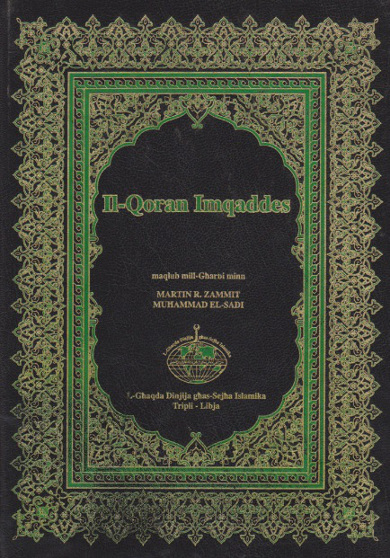The Maltese language, with its half-million speakers, belongs to the Semitic language family. Although most of the Muslim minority population in Malta (which totaled around 30,000 people in 2020) have various migrant backgrounds, the community primarily uses two Maltese translations of the Qur’an. The first was prepared in the 1990s by a Catholic theologian, Edmund Teuma, while the second is the product of a joint project carried out by Martin R. Zammit, a scholar of Arabic studies, and local imam Muhammad el-Sadi. This work, Il-Qoran Imqaddes, which provides a good example of a cooperative endeavor by a Muslim activist and an academic scholar, was supported by the World Islamic Call Society (WICS) based in Tripoli, Libya, and was first published by them in 2008.

Published together with the Arabic text (in the Ḥafṣ reading) in a page-to-page format, Il-Qoran Imqaddes is surely one of the most successful of the WICS projects. ‘As it is a translation into another semitic language, the linguistic similarities between the source and target text give the translators a good opportunity to both convey the original Qur’anic meaning and nuance, and to do so in a way that has rhetorical merit’. The volume opens with a small preface in both Arabic and Maltese, describing the approach undertaken as ‘a work which represents the Qur’an from the Islamic perspective’. When it comes to the target language, the translators have made an attempt to preserve Arabic words found in the Maltese language as long as they do not contradict the original meaning in terms of basic Qur’anic vocabulary. However, despite the closeness of Maltese and Arabic, words do not always carry the same lexical meanings, and some words were also considered archaic in the Maltese context. In such cases, as the preface explains, some additional explanatory comments were added to the translation. As supplement, the translation also includes a list of the Divine Names (‘L-Isbaħ Ismijiet Ta’ Alla l-Imbierek’) in Arabic, transcription and Maltese. Many of these actually sound similar to the original, for example al-Quddūs becomes ‘il-Qaddis’, and al-Salām becomes ‘Is-Sliem’, while al-Khāliq becomes ‘il-Ħallieq’, etc.

The core text of the translation is preceded by a ‘Daħlah għal kull Sura’ (‘Introduction to all surahs’) with a short description of the content. This takes up 40 pages (pp. 20–59), and is unusual. Most translations into other languages usually provide separate introductions at the beginning of each surah, and such a long all-in-one outline is not the norm at all. When it comes to the text of the surahs, the wording seems to be based on the ‘explanatory translation’ concept: there are plenty of insertions in brackets, most of which explain the meaning of individual words. This approach has generally helped the authors to avoid adding many footnotes; a tactic which is enhanced by the provision of a ‘General Dictionary’ (‘Tagħrif Ġenerali’) at the end of the volume, in which lot of Arabic terms are explained (pp. 605–619). What seems to be really unique to this translation is the usage of more commonly used words in Maltese derived from the Arabic to reproduce the Qur’anic vocabulary. For example, in Q 1:2 and 4–6 one may read: ‘It-titħir Iil Alla, Sid il-ħolqien … Is-Sultan ta’ Jum il-Ħaqq. Lilek inqimu, u lilek nitolbu għajnuna. Mexxina fit-triq id-dritta …’: it is obvious that this passage contains a lot of Arabic loan words like ‘Sid’ (Sayyid, colloquial Sid), ‘ħolqien’ (khalāīʾīq). Sultan (Sulṭān), etc. This means that, in this particular case, the process of translation sometimes reads more like an exercise in writing tafsīr in Arabic than interpreting the text in a completely different language. Still, some of the same basic Qur’anic concepts are sometimes translated using the modern lexicon, such as the word dīn (‘religion’) in Q 2:226 (lā ikrāha fī ‘l-dīn: ‘ma hemm edba ġegħil fir-religion’), while others are preserved and thus changed into a Maltese form: (lakum dīnakum: ‘intom għandkom id-din’, Q 109:6). The lack of references to tafsīr literature, or to any particular exegetical issues, make this translation less theologically-oriented than some others. Likewise, the linguistic closeness of Arabic and Maltese opens up many possibilities for the translator to preserve the original Qur’anic word order, for instance when it comes to basic vocabulary and some stylistic elements, such as the usage of ‘qala’ for qāla (‘he said’).
After its initial printing in 2008 and 2009, most of the copies of this translation were distributed in Malta, although it is also available on some Islamic websites. So far, the 2008 edition seems to be the only edition to be published. Apart from its significance for the Muslim community, this translation also remains a very important text for the development of the modern Maltese language.
Mykhaylo Yakubovych
